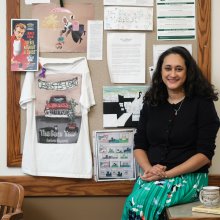
It is an enduring truth that English classrooms are shaped not only by the texts we teach but by how — and why — we teach them. In a new collection titled Design and Discomfort: Teaching Shakespeare and Race, recently published by the ACMR Press, a cohort of educators comes together to ask the question: What if we treated Shakespeare not as a monument to be admired, but as a portfolio to be interrogated?
Among the contributors is Western Reserve Academy’s own Sasha Maseelall ’96, whose essay “Many Stories at Once: On Teaching Shakespeare Within a Framework of Polyphonic Discomfort” sits at the intersection of education, identity and literary lineage. In it, she reflects on teaching a senior English elective at WRA that pairs Othello with Toni Morrison’s Desdemona — a rare and haunting collaboration by Morrison, Rokia Traoré and Peter Sellars that gives voice to women silenced in Shakespeare’s work.
Drawing from her participation in the Transforming Shakespeare’s Tragedies program and the RaceB4Race education symposium, Maseelall explores how students can develop what scholar Ariane Balizet calls a “polyphonic” reading practice — one that listens deeply for the many, sometimes conflicting stories within and beyond a text. As such, in her classroom, the Bard does not stand alone. He is placed deliberately in conversation with other voices, other histories, other perspectives and other truths. Maseelall’s students engage in dialectical journals, Socratic seminars and open-ended creative projects, among them an adaptation of Sula titled Burn, a project conceived by current students (now alumnae) Angelina Agresta ’24, Elba Heddesheimer ’23, Sara J. ’23, Sheilla M. ’23, and Jenny W. ’23 and staged as a collective response to a semester’s readings. What emerges is a literature course that is less about mastering and memorizing lines in iambic pentameter and more about opening spaces for comprehension and reckoning.
Maseelall writes openly about her hesitations toward teaching Shakespeare, the shifting conversations about race and curriculum in the wake of George Floyd’s murder in 2020, and ultimately the transformation that comes when students are invited not just to read texts, but to listen deeply to them and to each other. She invites educators to embrace discomfort, challenge traditional hierarchies in the English classroom and teach with love.
Design and Discomfort, edited by Laura B. Turchi, is both a conceptual and practical volume. It offers essays and lesson plans that ask teachers to do as Maseelall suggests — to embrace discomfort, to not see it as a barrier to teaching but a realm of possibility. “We still have our classrooms,” writes Amrita Dhar (cited in Maseelall’s chapter), “our desks, our libraries, our discussions — all of which we can use to imagine necessary transgressions.”
In Maseelall’s classroom, that imagining becomes lived practice. Her work, like the book itself, insists that teaching literature is never neutral. It is a form of storytelling and truth-telling, and even a form of love.
Design and Discomfort: Teaching Shakespeare and Race is available as an open-access volume on Arizona State University’s pressbooks library. You are invited to read Maseelall’s chapter here.
Congratulations to our colleague! We are proud of your scholarship, your devotion to student voice and your commitment to evolving what literature education can be.





















